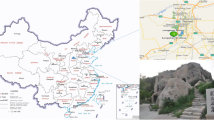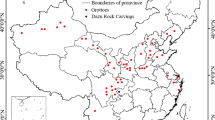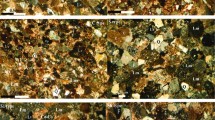Abstract
Numerous ancient sandstone grottoes remain in northwest and central China, and weathering issues have significantly influenced their preservation conditions. The dramatic naturally cyclic changes in water content and temperature in the environment have been considered to be the main drivers of the physical weathering that commonly occurs at these archaeological sites. Therefore, comparing and understanding the behaviors of sandstone with different weathering degrees under variable environmental conditions would be helpful for further study on predicting the type, location and extent of deterioration of sandstone relics in a small region (such as the surrounding rock of grottoes). This study examines Cretaceous sandstones with two weathering degrees from Bingling Temple Grottoes, China. Standard thin section photomicrographs provide petrographic and mineralogical data and show that the sandstones have identical lithologies. Three types of specifically designed frost weathering tests are then conducted on the samples. After every six weathering cycles, the weathering processes are suspended, and the corresponding parameters, such as dry weight loss, dry density, effective porosity, porosity, P wave velocity, surface hardness and drilling resistance, are measured. At the end of the weathering cycles, the sample variations in grain size distributions are compared, and statistical tests are performed to show the statistical significance of the results. The results indicate that similar deterioration patterns occur on the samples with two weathering degrees under the same weathering tests. The increase in effective porosity surpasses that of the porosity only when the weathering effect is large enough. Furthermore, sandstone with a high degree of weathering might be more susceptible to changes in the internal pores due to its greater initial interconnectivity. In an open system, physical weathering (frost–thaw and dry–wet cycles) would cause the superficial grain size distributions of different rocks to become relatively uniform. Finally, when exposed to the same weathering process, the decreases in the overall mechanical strength in the two sandstones do not differ significantly, but the loss of superficial strength may be different.














Similar content being viewed by others
References
Anon (1981) Basic geotechnical description of rock masses. Int J Rock Mech Min 18:87–110
Aoki H, Matsukura Y (2007) A new technique for non-destructive field measurement of rock-surface strength: an application of the Equotip hardness tester to weathering studies. Earth Surf Process Landf 32:1759–1769
ASTM D5312 (2013) Standard test method for evaluation of durability of rock for erosion control under freezing and thawing conditions. ASTM Standards
Benavente D, Cultrone G, Gómez-Heras M (2008) The combined influence of mineralogical, hygric and thermal properties on the durability of porous building stones. Eur J Mineral 20:673–685
Bruthans J, Filippi M, Schweigstillová J, Řihošek J (2017) Quantitative study of a rapidly weathering overhang developed in an artificially wetted sandstone cliff. Earth Surf Process Landf 42:711–723
Chen W, Dai P, Yuan P, Zhang J (2016) Effect of inorganic silicate consolidation on the mechanical and durability performance of sandstone used in historical sites. Constr Build Mater 121:445–452
Chen TC, Yeung MR, Mori N, (2004) Effect of water saturation on deterioration of welded tuff due to freeze-thaw action. Cold Reg Sci Technol 38(2-3):127–136
Chiu CF, Ng CWW (2014) Relationships between chemical weathering indices and physical and mechanical properties of decomposed granite. Eng Geol 179:76–89
Dearman WR (1995) Description and classification of weathered rocks for engineering purposes: the background to the BS5930:1981 proposals. Q J Eng Geol Hydrogeol 28:267–276
Franzini M, Leoni L, Lezzerini M, Cardelli R (2007) Relationships between mineralogical composition, water absorption and hydric dilatation in the "Macigno" sandstones from Lunigiana (Massa, Tuscany). Eur J Mineral 19:113–123
Gokceoglu C, Zorlu K, Ceryan S, Nefeslioglu HA (2009) A comparative study on indirect determination of degree of weathering of granites from some physical and strength parameters by two soft computing techniques. Mater Charact 60:1317–1327
Halsey DP, Mitchell DJ, Dews SJ (2004) Influence of climatically induced cycles in physical weathering. Q J Eng Geol Hydrogeol 31:359–367
Heidari M, Torabi-Kaveh M, Chastre C, Ludovico-Marques M, Mohseni H, Akefi H (2017) Determination of weathering degree of the Persepolis stone under laboratory and natural conditions using fuzzy inference system. Constr Build Mater 145:28–41
Khanlari G, Abdilor Y (2014) Influence of wet-dry, freeze-thaw, and heat-cool cycles on the physical and mechanical properties of Upper Red sandstones in central Iran. Bull Eng Geol Environ 74:1287–1300
Li Z (1985) Weathering research of Bingling Temple Grottoes, Maijishan Grottoes and North Grottoes of Qingyang. Wenbo 3:66–75 (in Chinese)
Li L, Shao M, Wang S, Li Z (2011) Preservation of earthen heritage sites on the Silk Road, northwest China from the impact of the environment. Environ Earth Sci 64:1625–1639
Lourenço PB, Luso E, Almeida MG (2006) Defects and moisture problems in buildings from historical city centres: a case study in Portugal. Build Environ 41:223–234
Marques EAG, Barroso EV, Filho APM, Vargas EA (2010) Weathering zones on metamorphic rocks from Rio de Janeiro—Physical, mineralogical and geomechanical characterization. Eng Geol 111:1–18
Martínez-Martínez J, Benavente D, Gomez-Heras M, Marco-Castaño L, García-del-Cura MÁ (2013) Non-linear decay of building stones during freeze-thaw weathering processes. Constr Build Mater 38:443–454
McAllister D, Warke P, McCabe S (2017) Stone temperature and moisture variability under temperate environmental conditions: Implications for sandstone weathering. Geomorphology 280:137–152
McCabe S, Smith BJ, Warke PA (2006) Preliminary observations on the impact of complex stress histories on sandstone response to salt weathering: laboratory simulations of process combinations. Environ Geol 52:251–258
McCabe S, Smith BJ, Warke PA (2007) Sandstone response to salt weathering following simulated fire damage: a comparison of the effects of furnace heating and fire. Earth Surf Process Landf 32:1874–1883
National Standards Compilation Group of People’s Republic of China (2009) Code for investigation of geotechnical engineering (GB/T 50021). China Building Industry Press, Beijing (in Chinese)
National Standards Compilation Group of People’s Republic of China (2013) Standard for tests method of engineering rock masses (GB/T 50266). China Plan Press, Beijing (in Chinese)
Nefeslioglu HA (2013) Evaluation of geo-mechanical properties of very weak and weak rock materials by using non-destructive techniques: Ultrasonic pulse velocity measurements and reflectance spectroscopy. Eng Geol 160:8–20
Nicholson DT, Nicholson FH (2015) Physical deterioration of sedimentary rocks subjected to experimental freeze–thaw weathering. Earth Surf Process Landf 25:1295–1307
Özşen H, Bozdağ A, İnce İ (2017) Effect of salt crystallization on weathering of pyroclastic rocks from Cappadocia, Turkey. Arab J Geosci 10:258
Pappalardo G (2014) Correlation Between P-Wave Velocity and Physical–Mechanical Properties of Intensely Jointed Dolostones, Peloritani Mounts, NE Sicily. Rock Mech Rock Eng 48:1711–1721
Ruedrich J, Bartelsen T, Dohrmann R, Siegesmund S (2010) Moisture expansion as a deterioration factor for sandstone used in buildings. Environ Earth Sci 63:1545–1564
Shao M, Li L, Wang S, Wang E, Li Z (2013) Deterioration mechanisms of building materials of Jiaohe ruins in China. J Cult Herit 14:38–44
Stavropoulou M (2006) Modeling of small-diameter rotary drilling tests on marbles. Int J Rock Mech Min 43:1034–1051
Tandon RS, Gupta V (2014) Estimation of strength characteristics of different Himalayan rocks from Schmidt hammer rebound, point load index, and compressional wave velocity. Bull Eng Geol Environ 74:521–533
Tiano P, Delgado R, De W et al (2002) The conservation of monuments: a new method to evaluate consolidating treatments. Restorations Buildings Monuments 6:133–150
Viles H, Goudie A, Grab S, Lalley J (2011) The use of the Schmidt Hammer and Equotip for rock hardness assessment in geomorphology and heritage science: a comparative analysis. Earth Surf Process Landf 36:320–333
Wang H (1990) The influence of temperature change on the Bingling Temple Grottoes. J Dunhuang Stud 18:106–111 (in Chinese)
Weiss T, Siegesmund S, Kirchner D, Sippel J (2004) Insolation weathering and hygric dilatation: two competitive factors in stone degradation. Environ Geol 46:402–413
Wilhelm K, Viles H, Burke O, Mayaud J (2016) Surface hardness as a proxy for weathering behaviour of limestone heritage: a case study on dated headstones on the Isle of Portland, UK. Environ Earth Sci 75:1–16
Yang S, Wei Q, Mathias K, et al (2012) Research of weathering reinforcement and protection of Anyue Grottoes. Proceedings of the 7th academic annual conference of China Cultural Relics Protection Technology Association (in Chinese)
Zhang Z, Pendin VV, Feng WJ et al (2015) The influence of freeze-thaw cycles on the granulometric composition of Moscow morainic clay. Sci Cold Arid Reg 7(3):0199–0205
Zhang M, Zhang H, Xu J et al (1996) Environmental geologic problems in protection of Bingling Temple Grottoes. J Arid Land Resour Environ 10(1):58–63 (in Chinese)
Zhao X, Yanjun HE, Yan H, Liang YU (2015) Influence of silt sediments on the Bingling Temple Grottoes and resulting treatment measures. Dunhuang Res 152:136–140 (in Chinese)
Acknowledgements
This study was supported by Science and Technology Major Project of Gansu Province (18ZD2FA001). Special thanks to Dunhuang Academic (China) and Research Institute for the Cultural Relics of Bingling Temple Grottoes (Gansu Province, China), for helping us do field works in Bingling Temple Grottoes.
Author information
Authors and Affiliations
Corresponding author
Rights and permissions
About this article
Cite this article
Chen, W., Liao, R., Wang, N. et al. Effects of experimental frost–thaw cycles on sandstones with different weathering degrees: a case from the Bingling Temple Grottoes, China. Bull Eng Geol Environ 78, 5311–5326 (2019). https://doi.org/10.1007/s10064-018-01454-2
Received:
Accepted:
Published:
Issue Date:
DOI: https://doi.org/10.1007/s10064-018-01454-2




